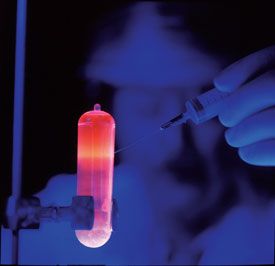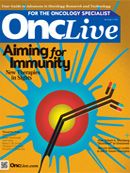Game-Changers: 11 Key Abstracts in ASCO Lineup
Abstracts presented at the 2011 ASCO Annual Meeting will have a major impact on both standard-of-care disease management and the future of clinical trials in multiple settings.

Purified DNA, fluorescing orange under ultraviolet (UV) light, is extracted and used for molecular biology studies. The purified DNA, in a cesium chloride gradient, binds to the ethidium bromide dye which absorbs UV light and makes the DNA fluoresce orange. This visualization of a single band of DNA aids in the isolation and extraction of the DNA for future molecular biology studies.
Abstracts presented at the 2011 American Society of Clinical Oncology (ASCO) Annual Meeting will have a major impact on both standard-of-care disease management and the future of clinical trials in multiple settings. While it is certainly not possible to adequately discuss the more than 4000 abstracts presented at this important congress, this commentary will highlight a few of the reports that have the potential to change the paradigm for disease management.
1
Melanoma
Vemurafenib Response Impressive
A number of commentators have noted that this was the “year of melanoma treatment.” In fact, in the plenary session, 2 paradigmchanging randomized phase III trials involving patients with advanced melanoma were presented. In the first report, investigators randomized patients with metastatic melanoma and a documented activated BRAF mutation to either vemurafenib, an inhibitor of mutated activated BRAF, or dacarbazine. The vemurafenib-treated patient population experienced a strikingly higher objective response rate (48.4% vs 5.5%), progression-free survival (hazard ratio [HR] 0.26, P <0.0001) and overall survival (HR 0.37, P <0.0001). Abstract LBA4
2
Ipilimumab Data Confirm Potency
In the second plenary abstract dealing with melanoma, investigators compared dacarbazine with dacarbazine plus ipilimumab, a novel immunotherapy strategy, in a phase III randomized study as primary treatment of either unresectable stage III or metastatic stage IV melanoma. Treatment on the ipilimumab-containing regimen resulted in a higher objective response rate (15.2% vs 10.3%), and improved progression-free response (median 2.8 vs 2.6 months, HR 0.76; P = 0.006) and overall (median 11.2 vs 9.1 months, HR 0.72, P = 0.0009) survival. Three-year overall survival was almost doubled (20.8% vs 12.2%) in the ipilimumab arm. Of note, the duration of response in those individuals randomized to the ipilimumab regimen increased from a median of 8.1 months observed in the dacarbazine arm to 19.3 months. Abstract LBA5
3
GIST
Extended Imatinib Outcomes Are Dramatic
In the realm of gastrointestinal stromal tumors (GIST), a potentially paradigm-changing study explored the impact of 12 months versus 36 months of adjuvant imatinib in a high-risk patient population who received the agent in the adjuvant setting following surgical resection. The study revealed a statistically significant improvement in both 5-year relapse-free survival (65.6% vs 47.9%; HR 0.46; P <0.0001) and 5-year overall survival (92% vs 81.7%; HR 0.45; P <0.019) associated with the extended treatment program. The data not only provide strong support for the superiority of the extended adjuvant treatment program, but also raise the provocative question of whether such treatment should be continued for longer than 3 years. Abstract LBA1
4
Pediatric Oncology
2 Regimens Show Favorable Impact
5
There were 2 reports in the plenary session focusing on important management questions in the realm of pediatric oncology. The first study involving more than 2000 children and young adults with acute lymphoblastic leukemia (ALL) documented the unequivocal superiority of high-dose methotrexate versus an alternative approach to methotrexate delivery in high-risk ALL. The second study in this category revealed the favorable impact on overall survival associated with a myeloablative busulphan/melphalan chemotherapy program compared with carboplatin/etoposide/melphalan among individuals with high-risk neuroblastoma. Abstracts LBA3, LBA2
6
Ovarian Cancer
Bevacizumab Combination Supported
Investigators compared in a phase III study the combination of carboplatin plus gemcitabine versus this regimen plus bevacizumab as treatment of potentially platinum-sensitive recurrent ovarian cancer. Treatment on the antiangiogenic-containing regimen was associated with a highly statistically significant favorable impact on time-to-subsequent disease progression (median 12.4 vs 8.4 months, HR 0.484, P <0.0001), but to date no improvement in overall survival (median 35.5 vs 29.9 months, HR 0.751, P = 0.094) has been observed. Abstract LBA5007
7
Olaparib Shows Maintenance Benefit
In another most interesting randomized phase II trial, investigators compared maintenance treatment with olaparib, a PARP inhibitor with previously documented single-agent activity in ovarian cancer, versus placebo as a maintenance strategy following treatment with secondline platinum-based chemotherapy in women with high-grade serous tumors. Individuals randomized to olaparib experienced a significantly prolonged time to subsequent disease progression (median 8.4 vs 4.8 months, HR 0.35, P <0.00001). Data on overall survival were immature at the time of this presentation. Abstract 5003
8
Breast Cancer
Exemestane Sharply Cuts Malignancy Risks
In the breast cancer arena, a phase III trial involving 4560 patients revealed the administration of exemestane for primary prevention in postmenopausal women resulted in a >50% reduction in the risk of the malignancy (HR 0.35, P = 0.002). With a median follow-up of 3 years, there were 11 invasive breast cancers in the exemestane-treated individuals versus 32 in the placebo group. Abstract LBA504
9
Bevacizumab Bests 2 HER2-negative Options
Investigators explored the utility of adding capecitabine, gemcitabine, or bevacizumab to a regimen of docetaxel followed by cyclophosphamide plus doxorubicin delivered as neoadjuvant therapy of operable HER2-negative breast cancer. The principal study endpoint was the percentage of patients achieving a pathological complete response. The study revealed that the addition of neither of the 2 cytotoxic drugs improved outcome, but the addition of bevacizumab resulted in a statistically significant improvement in the relevant clinical surrogate endpoint of pathological complete response (34.5% vs 28.4%, P = 0.027). The clinically defined complete response rate was also increased following the addition of the antiangiogenic agent (64.3% vs 55.8%, P = 0.007). It is relevant to note that an important clinical issue in the use of bevacizumab in the neoadjuvant setting is wound healing following the planned surgery. Abstract LBA1005
10
Lung Cancer
Gene Mutation Analyses Revealing
Researchers reported an analysis involving 830 tumors from patients with adenocarcinoma of the lung to define which proportion of these cancers contained mutations that would result in therapeutic strategies specifically based on these molecular findings. Overall, approximately 60% of the tumor samples were found to possess such abnormalities, including approximately 25% of patients with KRAS and EGFR mutations, a 6% incidence of ALK rearrangements, and a 3% incidence of BRAF abnormalities. These data provide important support for the routine molecular evaluation of adenocarcinomas to define specific defects that may direct appropriate therapy. Abstract CRA7506
11
Molecular Testing
Influence on Clinical Trials Suggested
Investigators from the phase I program of the University of Texas MD Anderson Cancer Center provided another view of the potentially profound impact of molecular testing of individual patient tumor samples. In a group of 116 patients who participated in a phase I trial at that institution where there was no specific molecular match of the patient’s cancer for a suggested activity of the phase I drug in preclinical testing, the objective response rate was 5%. However, in a population of 175 patients where such a match led to the selection of a particular phase I trial based on individual molecular testing, the objective response rate was 27% (P <0.0001). Abstract CRA2500
Postscript: Molecular Targets Mushrooming
Abstracts presented at this meeting clearly indicate that in the future there will be an increasing focus on treatment based on knowledge of the unique molecular features present within an individual patient’s cancer. Existing data suggest this approach has the potential to both increase the chances a patient will receive a therapy that will be clinically effective, and reduce the risk for the administration of inactive but potentially harmful antineoplastic agents.
Maurie Markman, MD, editor-in-chief of OncLive, is vice president of Patient Oncology Services and national director for Medical Oncology at Cancer Treatment Centers of America, Eastern Regional Medical Center, Philadelphia, Pennsylvania. maurie.markman@ctca-hope.com




